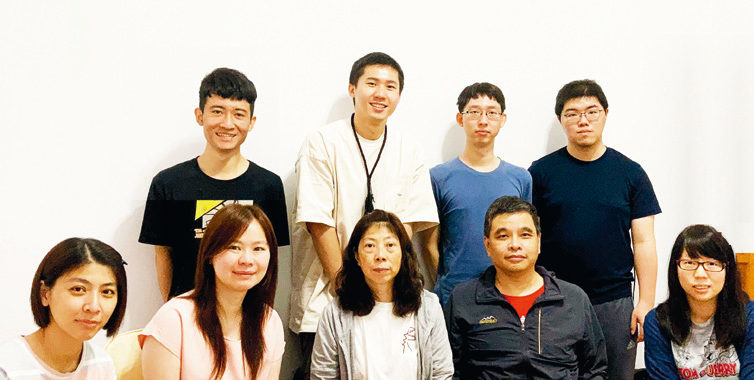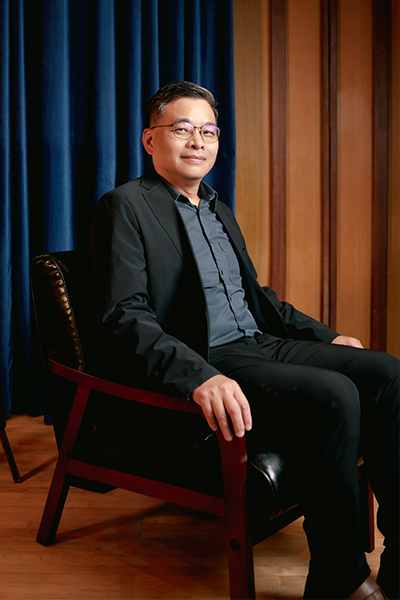The Mechanism of Genetic Recombination in Meiosis
Meiosis lies at the heart of Mendelian heredity. During meiosis, cells deliberately form numerous DNA double-strand breaks in order to initiate homologous recombination, by which genetic information can be exchanged between homologous chromosomes and chromosome segregation is accurately achieved. Abnormalities in meiotic recombination cause human infertility, developmental defects (e.g., Down syndrome) and cancers. Meiosis is also a crucial process in the breeding of organisms beneficial to humans, including fungi, plants and animals.
We have been interested in understanding the mechanisms that mediate homologous recombination, the DNA damage response, chromosome dynamics and genome defense during meiotic prophase. Most of our current knowledge about meiotic recombination, chromosome dynamics and genome instability has been derived from studies on purebred meiosis, whereby zygotes are generated by fertilizing or mating two near isogenic gametes or ascospores (fungal sexual spores), respectively. If the genome sequences of interspecies or intraspecies hybrid zygotes are too diverged to cross over efficiently, the mismatch repair (MMR) system contributes to hybrid infertility. The anti-recombinogenic function of the MMR system has implications for theories of evolution and speciation, yet the mechanistic relationships among the DNA repair enzymes that act as MMR enzymes and heteroduplex basepair mismatches remain unclear.
We have applied multidisciplinary experimental approaches (e.g., Classical Genetics, Molecular Biology, Biochemistry, Biophysics, Proteomics, Genomics and Bioinformatics) to delineate the molecular and regulatory mechanisms of meiotic recombination, chromosome dynamics and genome defense. The favored model systems are the budding yeast Saccharomyces cerevisiae SK1/S288c hybrid and the industrial workhorse fungus Trichoderma reesei QM6a/CBS999.97 hybrid. For three reasons, these two ascomycete fungi are ideal model organisms for understanding evolutionary diversity of meiosis. First, the near-complete (telomere-to-telomere) sequences of the haploid genomes from SK1/S228c and QM6a/CBS999.97 hybrid zygotes display >12% and >18% sequence heterozygosity, respectively. Despite highly diverse genome sequences, these two intraspecies hybrids exhibit high fertility . Second, due to their small genome sizes and the huge advantage afforded by being able to recover all four meiotic products. Third, unlike Saccharomyces cerevisiae, Trichoderma reesei possesses two DNA cytosine methylases and exhibits repeat-induced point mutation (RIP) during meiosis. RIP is a fungus-specific genome defense mechanism that mitigates the deleterious consequences of repeated genomic regions and transposable elements. RIP mutates targeted sequences by introducing cytosine (C) to thymine (T) transitions.
- PDF, 1999-2000, Dept. Mol. & Cell Biol., Harvard Univ. USA
- Ph.D., 1998, Dept. Mol. & Cell Biol., Harvard Univ. USA
- MS, 1990, Inst. Life Science., Natl. Tsing Hua Univ.
- BS, 1988, Dept. Chemistry, Natl. Taiwan Univ.
- Chen, C.L, Li, W.C., Chuang, Y.C., Liu, H.C., Huang, C.H., Lo, K.Y., Chen, C.Y., Chang, F.M., Chang, G. A., Lin, Y.L., Yang, W.D., Su, C.H., Yeh, T.M. and *Wang T.-F. (2022) Sexual crossing, chromosome-level genome sequences, and comparative genomic analyses for the medicinal mushroom Taiwanofungus camphoratus (Syn. Antrodia cinnamomea, Antrodia camphorata). Microbiology Spectrum 10, e02032-21. PMID:35196909
- Li, W.C., Lin, T.C., Chen, C.C., Liu, H.C., Lin, H.N., Chao, J.L., Hsieh, C.H., Ni, H.F., Ruey- Chen, R.S.* and *Wang T.-F. (2021) Complete genome sequences and genome-wide characterization of Trichoderma biocontrol agents provide new insights into their evolution and variation in genome organization, sexual development, and fungal-plant interactions. Microbiology Spectrum 9, e00663-21. PMID:34908505.
- Li, W.-C. #, Lee C.-Y. #, Lan, W.-H. #, Woo, T.-T. #, Liu, H.-C., Yeh, H.-Y., Chang, H.-Y., Chuang, Y.-C., Chen, C.-Y., Chuang, C.-N., Chen, C.-L., Hsueh, Y.-P., Li, *W.-H., P, *Chi., and *Wang T.-F. (2021) Trichoderma reesei Rad51 tolerates mismatches in hybrid meiosis with diverse genome sequences. Proc. Natl. Acad. Sci. USA 118. PMID: 33593897.
- Liu, H.-C. #, #Li, W.-C.#, and *Wang, T.-F.* (2020) TSETA: a third-generation-sequencing based program for single-nucleotide-resolution mapping of meiotic recombination products and repeat-induced point mutations. Methods in Molecular Biology 2234: 331-361. PMID: 3316579.
- Woo, T.T., Chuang, C.N., Higashide, M., Shinohara, A., *Wang, T.F. (2020) Dual roles of yeast Rad51 N-terminal domain in repairing DNA double-strand breaks. Nucleic Acids Research 48, 8474-8489 PMID:32652040.
- Li, W.-C., Huang, C.-H., Chen, C.-L., Chuang, Y.-C., Tung, S.-Y. and *Wang T.-F. (2017) Trichoderma reesei complete genome sequence, repeat-induced point mutation and partitioning of CAZyme gene clusters. Biotechnology for Biofuels 10:170 PMID:28690679
- Chen, Y.-J., Chuang, Y.-C., Chuang, C.-N., Cheng, Y.-H., Chang, C.-R., *Leng, C.-H. and *Wang, T.-F. (2016) Mre11 recruits conjugated SUMO moieties to facilitate the assembly and function of the Mre11-Rad50-Xrs2 complex. Nucleic Acids Research 44, 2199-2213. PMID:2.6743002
- Cheng, Y.-H., Chuang, C.-N., Shen, H.-J., Lin, F.-M. and *Wang, T.-F. (2013) Three different modes of Mec1/ATR and Tel1/ATM activation in budding yeast early meiosis. Molecular and Cellular Biology 33, 3365-3376. PMID: 23775120.
- Chuang, C.-N., Cheng, Y.-H. and *Wang, T.-F. (2012) Mek1 stabilizes Hop1-Thr318 phosphorylation to promote interhomolog recombination and checkpoint responses during yeast meiosis. Nucleic Acids Research 40, 11416-11427. PMID:23047948.
- Lai, Y.-J., Lin, F.-M., Chuang, M.-J., Shen, H.-J. and *Wang, T.-F. (2011) Genetic requirements and functions of phosphorylation of the yeast axial element protein Red1. Molecular and Cell Biology 31, 912-923
- Lin, F.-M., Lai, Y.-J., Shen, H.-J., Cheng, Y.-H. and *Wang, T.-F. (2010) Yeast axial element protein Red1 binds SUMO chains to promote meiotic interhomolog recombination and chromosome synapsis. EMBO Journal 29, 586-596. PMID:19959993
- Chen, L.-T., Ko, T.-P., Chang, Y.-C., Lin, K.-A., Chang, C.-S., *Wang, A. H.-J. and *Wang, T.-F. (2007) Crystal structure of the left-handed Archaeal RadA helical filament: Identification of a new functional motif for controlling quaternary structures and enzymatic activity of RecA family proteins. Nucleic Acids Research 35, 1781-1801. PMID:17329376.
- Cheng, C.-H., Lo, Y.-H., Liang, S.-S., Ti, S.-C., Lin, F.-M., Yeh, C.-H., Huang, H.-Y. and *Wang, T.-F. (2006) SUMO modifications control assembly of synaptonemal complex and polycomplex in meiosis of Saccharomyces cerevisiae. Genes & Development 20, 1986-1992. PMID: 16847351.
- Chen, Y.-K., Leng, C.-H., Olivares, H., Lee, M.-H., Chang, Y.-C., Kung, W.-M., Ti., S.-C., Lo, Y.-H., Wang., A. H.-J., Chang, C.-S., Bishop, D. K., Hsueh, Y.-P. and *Wang, T.-F. (2004) Heterodimeric complexes of meiosis-specific Hop2 and Mnd1 promote DNA recombination and homolog juxtaposition. Proc. Natl. Acad. Sci. USA 101, 10572-10577. PMID: 15249670.
- Wang, T.-F., Chin-Ning Chuang and Tai-Ting Woo. “Method and vector for enhancing protein expression”. US provisional application (63/036,704), Patent Cooperation Treaty application (PCT/US2021/036247) and Taiwan application (110120541).
- Wang, T.-F., “Method for producing segmental aneuploidy (SAN) strains of Trichoderma reesei via sexual crossing and SAN strains produced therefrom”. Patent Cooperation Treaty (PCT/US14/58654) and US (9598738B2), Taiwan (I570236) and People’s Republic of China (IA001/ACA081CN).
- Wang, T. F. and Yang, S.M. “Methods of producing virus-like particles of piconavirus using a small-ubiquitin-related fusion protein expression system”. US (8663951B2) and Taiwan (I415623).
- Wang, T.-F. “SUMO fusion protein expression system for producing native proteins”. USA 8034910BZ.


